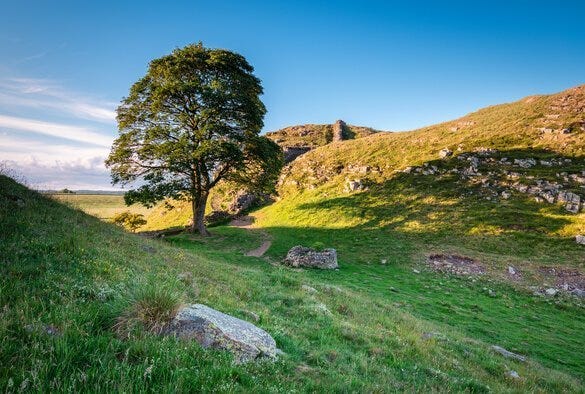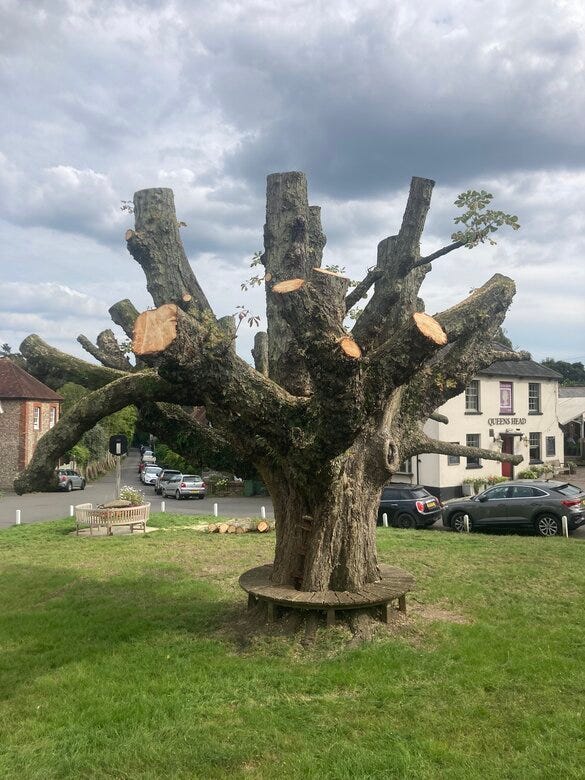Sycamore Gap Tree: What it tells us about the connection between humans and trees
Revisiting one of the biggest tree stories of 2023...
This article was originally published on The Tree Council website, back in October, following the devastating felling of the iconic Sycamore Gap Tree.
We hope all our wonderful Tree Talk readers are enjoying a peaceful end to 2023 - we’re delighted to have you with us, and to be celebrating topping 1,000 subscribers before the end of our first year. Good will to all!
The felling of the iconic Sycamore Gap Tree prompted anger and an outpouring of appreciation for trees across social and traditional media, but how does that translate into action, and how should the sector respond?
Ian Turner and Phil Paulo are The Tree Council’s Heads of Major Planting – both have decades of experience establishing trees, caring for trees and advising on best practice, for both public and private organisations.
For Ian, the felling was “a shock” and for Phil “very extreme”, with both reflecting that, unlike other circumstances that can result in mature tree loss, “the motives are not at all obvious in this case”.
Ian said: “The Sycamore Gap Tree was the right tree, in the right place, for the right reason, and it inspired people. People may not realise, but sycamore is entirely the right species for that location because it tolerates the upland conditions, with high winds and colder temperatures.
“It was a complete landscape, in microcosm, in that little cleft with that beautiful framing, right at the bottom of the valley with the wall coming down. People would go there and feel respite. It was a welcoming spot.
Phil said: “When you have a tree that is incredibly well shaped, it’s a piece of art, a living sculpture, and I think that was the case with this tree because of how it interacted with the landscape.
“People visited it, looked at it and captured it in the same way they would an Anish Kapoor sculpture – they’re getting emotion from it.
“That human appreciation of natural art is such an important thing that we shouldn’t forget in terms of valuing trees.”
Sadly, say Ian and Phil, humans damaging or felling trees in the UK is too common an occurrence; whether it’s “kids whacking a tree with a stick”, damage prompted by territorial disputes, or just straightforward vandalism and destruction.
Ian described a “beautiful” liriodendron, or tulip tree, used in a photoshoot for a photographer seeking images of sector figures, and their favourite trees. But returning recently, he “found it on the ground”.
Ian said: “It had decayed at the bottom of the tree, where the stem meets the roots, but someone had set light to this decayed part of the tree and it caused the remaining stem to snap. All that was left was the semi-living wood on the ground.
“It was quite shocking, having been there two to three years earlier, and describing its wonderful impact on the landscape, to suddenly go back and find it a husk – just nothing on the ground – as a result of human actions.”
Trees are complicated, living things, with loss often occurring through natural processes – making intentional destruction all the more galling.
Phil described a “big, statement horse chestnut” close to his home that developed a natural fault in high winds, and a fungal infection. It was “radically” pruned as a remedial measure.
Phil said: “That created a similar emotion in me because it was a tree that I’d always known and appreciated, that went from something very amazing to something very sad.”
For the Sycamore Gap Tree, or what is left of it, the future is unclear. Members of the public have suggested grafting it back together but this is impractical and probably impossible for a tree of this size and age, say Phil and Ian.
The stump may regrow but the resulting appearance would be completely different to what went before, with the tree forming many stems, rather than the iconic single stem and crown.
Phil said: “One option would be to plant a cluster of trees, including a sycamore, in that location and then thin them out as they develop. So, you go from a cluster of trees to a single tree over time.”
But both agree that the underlying issue remains the value placed on trees by humans, whether or not they are in iconic locations.
Ian added: “This is a random event that could have happened to a protected tree, so legal protections need to be better, but aren’t the only answer. It’s about trying to get to the heart of why people fell trees, why they feel the need to damage trees, and what their interest is in doing so.
“We say, the right tree in the right place for the right reason, but how that is valued depends on the person. We do need to value trees, whatever the location, and ensure that everyone is aware that they are part of them – that nature isn’t a target for their ire, or that somehow it doesn’t matter.
“It’s the non-acceptance of being part of nature that leads to its destruction.
“Respect for nature and humanity go hand in hand – we wouldn’t have these events if people felt that they were part of it, it would be like they were damaging themselves.”
Sycamore, or Acer pseudoplatanus to give it its scientific name, is a broadleaf tree that can reach 35m, and live for around 400 years. It is native to central, eastern and southern Europe and is thought to have been introduced to the UK by the Romans, with other reports suggesting it was introduced during the Tudor period, in the 1500s.
It has strong mythological symbolism. For the Ancient Greeks it was associated with Hera, the queen of the gods, and goddess of marriage and childbirth; while the Celts believed it was home to spirits, and often planted sycamores near their homes for protection. In Norse mythology, the sycamore is associated with Freya, the goddess of love, fertility and war – she was often depicted sitting in a sycamore tree.
The Sycamore Gap Tree was planted in the late 1800s by the previous landowner, John Clayton, to be a feature in the landscape. The land is currently managed by the National Trust.
Phil Paulo is The Tree Council’s Head of Major Tree Planting Projects and Ian Turner is The Tree Council’s Head of Planting & Ecology Projects Southern Region








Personally I’m still waiting to hear what the motivation was behind this cruelty